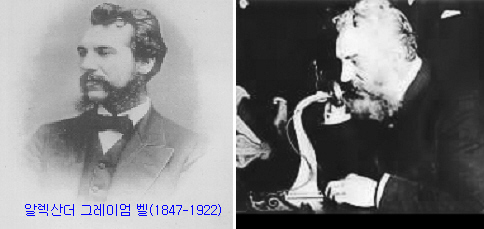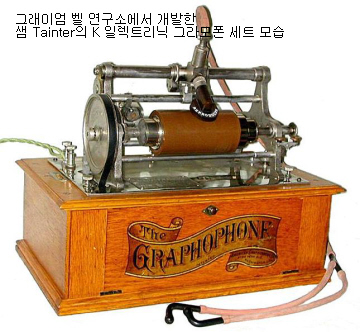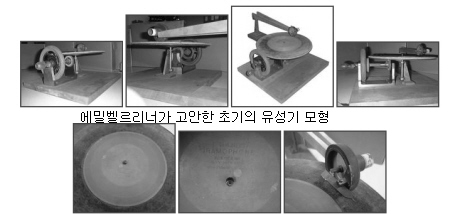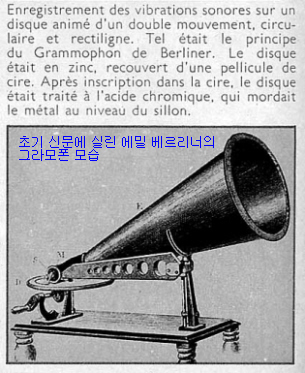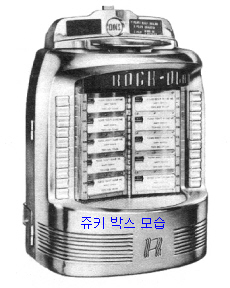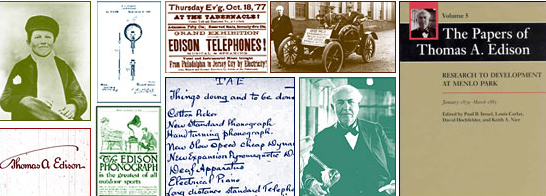
인류 역사와 함께 해온 소리의 예술인 음악은 에디슨의 유성기 발명 이후 영원한 인류의 동반자가 되었다. 지구상에서 최초로 인간의 목소리를 기록했다가 다시 들려준 유성기의 발명은 오늘날의 '오디오 공학'을 탄생시킨 위대한 첫걸음이었다.

당시 이 기기를 본 사람들은 자신의 귀를 의심하고 그 속에 악마가 들어 있다고까지 생각했다. 보잘 것 없는 간단한 구조를 가진 소리를 낼 수 있게 만든 뮤직 박스(Music Box)이지만, 사람의 상상력을 뛰어넘을 정도로 충격적인 것이었다.
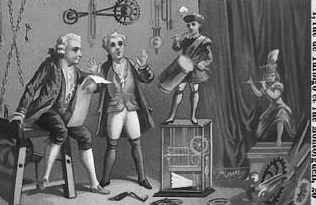
오디오시스템의 원조격인 소리통의 역사는 이미 13세기부터 시작되었다고 기네스북에 기록되어 있다. 1859년에 아이작 디스렐리의 ‘문학의 신기한 뒷이야기들’에 의하면 발명가인 알베르그 마그너스라는 천주교 교주가 처음으로 시도했는데 그와 가까운 친구인 토머스 아쿼나스가 신을 모독하는 행위라고 규탄하여 지팡이로 부숴 버렸다는 것이다.
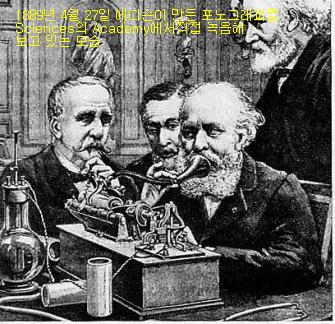
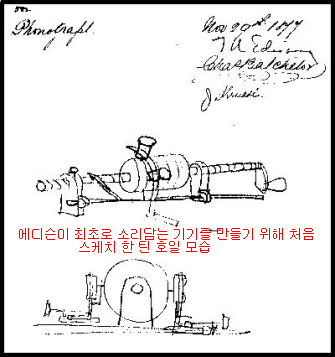
1857년 불란서의 과학자인 레온 스코트에 의해 이론이 전개되기 시작했는데 그가 내놓은 것은 종이에 음파를 기록한 것으로 오토그래프라고 했다. 이후 영국인 맥스웰은 1864년 전파의 존재를 예언했고 불란서의 시인이자 아마추어 발명가인 샤를로크는 가청현상과 재생기록 방식을 고안, 특허를 1877년에 얻으려 했으나 당시 필요한 경비 50프랑이 없어 결실을 보지 못하고 만 것이다.
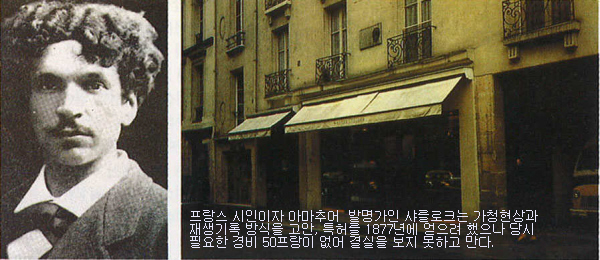
에디슨이 유성기를 발명해 낼 수 있는 방법을 알게 해준 것으로 1857년 영국인
Leon Scott de Martinville이 1857년에 발명한 기기를 보고 나서 었다.
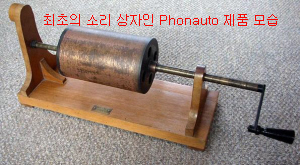
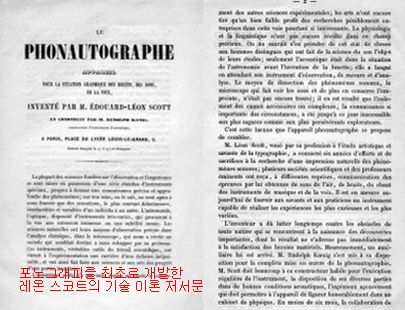
이 기기는 직접 소리를 기록해 줄 수 있었고 그것을 다시 들을 수 있게 제작된 인류 최초의 소리상자라고 할 수 있다. 20세기가 시작되기 전 에디슨은 레온 스코트의 기기를 대중화 제품으로 개발해 소개한 것이 바로 틴 호일(Tinfoil)이었다.
이 제품은 여러 타입으로 많은 회사들이 지금도 제작해 소개되고 있으며 오리지널이라고 할 수 있는 당시의 제품들이 전 세계에서 수집가들에 의해 아직도 보전되어있다.
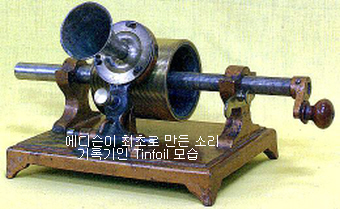
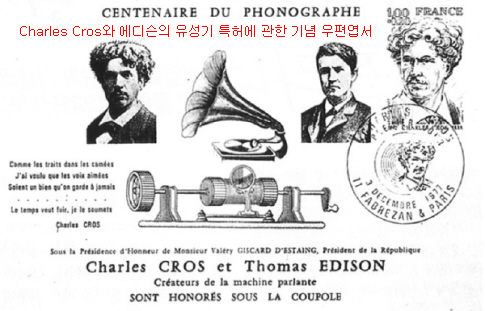
토마스 에디슨에 의해 이름이 붙쳐진 틴호일은 이후 포노그래피(Phonograph)라고 이름을 붙쳐 소개되었고 1878년 4월 18일 에디슨은 웨신톤에 있는 Sciences의 Academy에 틴호일 포노그래피 제품을 개선시킨 그의 두 번째 모델을 소개했다


토마스 에디슨(Thomas A. Edison 1847-1931)은 1877년 12월 실린더식 소리기록 재생장치인 틴호일을 탄생시켰고 오늘날 오디오 역사의 한 장(章)을 기록한 역사적인 일이다.
틴호일(Tinfoil) 포노그래프로 이름을 붙인 최초의 소리통은 실린더식 무쇠로 된 대반 중앙에 두개의 베어링식 기둥을 세우고 한쪽 끝에는 손잡이를 다른 끝에는 축을 꿰어 돌아갈 수 있도록 되어있다.
축 가운데에는 놋쇠와 같은 금속 철판으로 만든 실린더를 고정시켰는데 그곳에는 1인치당 10줄의 소리 골, 즉 홈이 새겨져 있다. 에디슨이 발명한 유성기를 석박(錫箔)식으로 포노그래프(Phono-graph)라고 불렀는데 당시 이 제품의 용도 설명을 보면 음악뿐만 아니라 만능기기로서의 역할을 할 수 있다고 했다.
The phonograph was developed as a result of Thomas Edison's work on two other inventions, the telegraph and the telephone. In 1877, Edison was working on a machine that would transcribe telegraphic messages through indentations on paper tape, which could later be sent over the telegraph repeatedly. This development led Edison to speculate that a telephone message could also be recorded in a similar fashion. He experimented with a diaphragm which had an embossing point and was held against rapidly-moving paraffin paper. The speaking vibrations made indentations in the paper. Edison later changed the paper to a metal cylinder with tin foil wrapped around it. The machine had two diaphragm-and-needle units, one for recording, and one for playback. When one would speak into a mouthpiece, the sound vibrations would be indented onto the cylinder by the recording needle in a vertical (or hill and dale) groove pattern. Edison gave a sketch of the machine to his mechanic, John Kreusi, to build, which Kreusi supposedly did within 30 hours. Edison immediately tested the machine by speaking the nursery rhyme into the mouthpiece, "Mary had a little lamb." To his amazement, the machine played his words back to him.
Although it was later stated that the date for this event was on August 12, 1877, some historians believe that it probably happened several months later, since Edison did not file for a patent until December 24, 1877. Also, the diary of one of Edison's aides, Charles Batchelor, seems to confirm that the phonograph was not constructed until December 4, and finished two days later. The patent (#200,521) on the phonograph was issued on February 19, 1878. The invention was highly original. The only other recorded evidence of such an invention was in a paper by French scientist Charles Cros, written on April 18, 1877. There were some differences, however, between the two men's ideas, and Cros's work remained only a theory, since he did not produce a working model of it.
Edison took his new invention to the offices of Scientific American in New York City and showed it to staff there. As the December 22, 1877, issue reported, "Mr. Thomas A. Edison recently came into this office, placed a little machine on our desk, turned a crank, and the machine inquired as to our health, asked how we liked the phonograph, informed us that it was very well, and bid us a cordial good night." Interest was great, and the invention was reported in several New York newspapers, and later in other American newspapers and magazines.
The Edison Speaking Phonograph Company was established on January 24, 1878, to exploit the new machine by exhibiting it. Edison received $10,000 for the manufacturing and sales rights and 20% of the profits. As a novelty, the machine was an instant success, but was difficult to operate except by experts, and the tin foil would last for only a few playings.
Ever practical and visionary, Edison offered the following possible future uses for the phonograph in North American Review in June 1878:
Letter writing and all kinds of dictation without the aid of a stenographer.
Phonographic books, which will speak to blind people without effort on their part.
The teaching of elocution.
Reproduction of music.
The "Family Record"--a registry of sayings, reminiscences, etc., by members of a family in their own voices, and of the last words of dying persons.
Music-boxes and toys.
①속기사 없이 편지를 쓸 수 있는 이외에 구술필기에도 사용할 수 있다.
②이것을 사용하면 맹인도 책을 읽을 수 있다.
③웅변술 교육에 사용할 수 있다.
④음악을 녹음, 재생시킬 수 있다.
⑤가족의 기록으로서 사람들의 육성이나 유언을 녹음할 수 있어 추억을 남길 수 있다.
⑥뮤직 박스 또는 장난감으로 쓸 수 있다.
⑦귀가시간이나 식사시간을 알려준다.
⑧발음을 정확하게 녹음하기 때문에 그 교정이 가능하다.
⑨선생님의 강의를 녹음해 두면 노트를 대신하게 되며 또한 단어의 스페링들 을 기억하는데도 유용하게 사용할 수 있다.
⑩전화와 유성기를 조합하여 그 통화를 영구 보존해 남길 수 있다는 것 등이었다.
레온 스코트에 의해 시작된 소리 상자 발명의 역사를 뒤돌아보면 아무도 1877년 사람의 소리를 복사 한다 것 잠재적인 가능성들을 인정하지 않았던 것은 놀라는 것이 당연하다.포노그래피는 엄격하게 말한다면 음파에 관한 시각의 연구에 대한 수단이라고 간주 되었다.에디슨은 레온 스코트의 발명을 일찍부터 알고 있었고 심지어 1878에서 민사 소송에서 증거를 위해 기차 소음을 녹음하기 위해 포노그래피를 사용 했다.이 방식은 여러 가지 모양으로 개발 많은 제조업자들에 의해 생산되었다.
이렇듯 에디슨이 공개한 유성기가 많은 사람들로부터 호응을 얻게 되자 '에디슨 유성기 회사'가 설립되었다. 그러나 재생되는 소리가 너무나 원시적이고 에디슨도 백열 전구 연구에 골몰하기 시작하자, 유성기는 더이상 발전되지 못했다.
실린더식 유성기는 이것에 흥미를 갖고 있던 몇몇 사람들에 의해 변모되기 시작했다. 그레이엄 벨(1847-1922)이 운영하고 있던 볼타 연구소 치체스터 벨 (그레이엄 벨의 조카)과 샘너 던터 두 사람은 주석 가루로 만들어 낸 에디슨의 포노그래프에 관심을 갖게 되었다. 그들은 주석 대신 왁스로 만든 원통형에 소리를 새겨 넣는 작업을 시작했다.
In the void left by Edison others moved forward to improve the phonograph. In 1880, Alexander Graham Bell won the Volta Prize of $10,000 from the French government for his invention of the telephone. Bell used his winnings to set up a laboratory to further electrical and acoustical research, working with his cousin Chichester A. Bell, a chemical engineer, and Charles Sumner Tainter, a scientist and instrument maker. They made some improvements on Edison's invention, chiefly by using wax in the place of tin foil and a floating stylus instead of a rigid needle which would incise, rather than indent, the cylinder. A patent was awarded to C. Bell and Tainter on May 4, 1886. The machine was exhibited to the public as the graphophone. Bell and Tainter had representatives approach Edison to discuss a possible collaboration on the machine, but Edison refused and determined to improve the phonograph himself. At this point, he had succeeded in making the incandescent lamp and could now resume his work on the phonograph. His initial work, though, closely followed the improvements made by Bell and Tainter, especially in its use of wax cylinders, and was called the New Phonograph.
The Edison Phonograph Company was formed on October 8, 1887, to market Edison's machine. He introduced the Improved Phonograph by May of 1888, shortly followed by the Perfected Phonograph. The first wax cylinders Edison used were white and made of ceresin, beeswax, and stearic wax.
1886년 5월 4일 불타 연구소가 개량된 포노그래프의 특허를 받아내자, 에디슨에게 더욱 진보된 기기를 함께 제작하자는 제안을 했다. 초기의 실린더 방식의 유성기는 청진기 같은 고무판을 사용해 주거나 큰 나팔관을 달아 주어야 하는 불편이 따라야 했다.
그들이 발명해 특허를 얻어낸 제품은 작동방식도 에디슨의 실린더가 손으로 돌려주는 것에 반해 이것은 톱니바퀴를 조립, 사용하기 편하게 된 설계였다. 이를 고안한 벨연구소에서 유성기에 관해 연구를 해온 알렉산더 그러험 벨의 사촌인 Chichester Bell과 물리학자인 Charles Sumner Tainter었다.
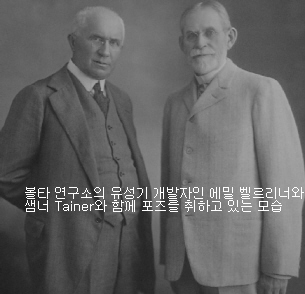
두 사람은 에디슨을 찾아가 기술제휴를 제안했지만 한마다로 거절당했다. 두 사람이 발명한 설계가 자기 것을 도용해 특허까지 받아낸데 화가 났다. 자신의 특허로만 알고 있었던 에디슨은 한동안 유성기 개발에 등한시했다.
이유는 노즈 아메리칸 포노그래피사가 1894년에 은행돈을 갚지 못해 파산에 이르게 된다. 설립자인 Jesse Lippincott는 2연후 사망했으며 동사의 사장을 에디슨이 맡게 되었고 이로 인해 법원 출입이 빈번해 졌으며 고민하게 된다.
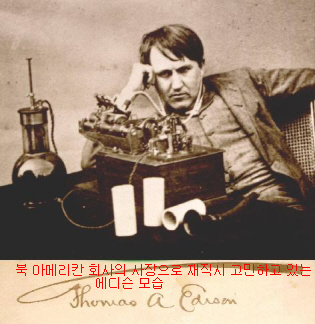
에디슨의 유성기 개발을 잠시 미루게 된다. 1890년 동사는 처음 채권을 발행했다. 이런 와중에 베를리너가 유성기에 적극적으로 뛰어들자 이에 당황한 사람은 에디슨 이였다.
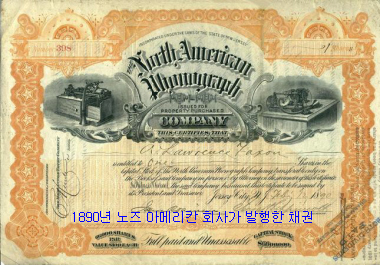
유성기 개발에 계속 베를리너에게 몰리고 있던 에디슨은 에밀 베를리너의 특허신청을 알고 나서 5일간 한잠도 자지 않을 정도로 유성기 개발에 대한 강한 집념을 보였다.
마침내 5일 만에 개량형 유성기를 완성시켰는데, 이것이 'M(E)형'이었다. 중량급으로 만들어진 이기기는 단순히 소리를 듣게 해주는 것보다 더욱 선명한 음악을 재생시켜 주는 기기로서 직류 모터를 사용한 최초의 유성기라는 점에서 가치를 두고 있다.

이 기기의 특징은 녹음 및 재생에 사용한 철심이 사파이어로서 기존 유성기와는 전혀 다른 기술을 보여준 것으로 지금도 이 제품은 명품으로 이름을 남기고 있다. 이 제품은 에디슨을 고용한 노즈 아메리카 유성기 회사를 통해 1989년부터 일반인들에게 판매되었다.
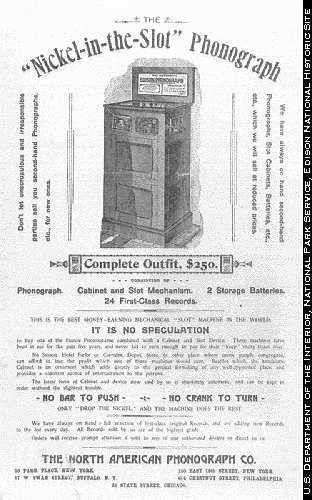
에디슨이 개발한 The Class M 유성기는 1877년 틴 포일 포노그래피에서 얻어진 아이디어로서 대형 제품이었다. 72시간 동안 마라톤 경기에 끝난 1888년 6월 16일의 아침에 그의 발명품이 드디어 탄생되었다.
중량급의 이 제품이 상품화되기는 1890년이었고 노즈 아메리칸 포노그래피사를 통해 판매되었다. 그러나 이 제품은 다른 제품이 미화 40불인 것에 비해 고가인 225불이여서 판매가 부진했다.
노즈 아메리칸 포노그래피사는 1894년에 은행돈을 갚지 못해 파산에 이르게 된다. 설립자인 Jesse Lippincott는 2연후 사망했으며 동사의 사장을 에디슨이 맡게 되었고 이로 인해 법원 출입이 빈번해 졌으며 고민하게 된다.
에디슨의 유성기 개발을 잠시 미루게 된다. 1890년 동사는 처음 채권을 발행했다. 노즈 아메리카 포노그래피사는 The Class M 유성기를 의회(議會)의 속기용으로 대여했다고 한다.
한편 벨연구소에서 유성기에 관해 연구를 해온 알렉산더 그러험 벨의 사촌인 Chichester Bell과 물리학자인 Charles Sumner Tainter는 Bell-Tainter Type K 이라는 유성기를 발명 에디슨의 Class M 유성기와 경쟁을 벌리게 된다
1895년 발명된 Type K 유성기는 6“ 대형 레코드를 사용할 수 있게 했고 판매가격도 미화 150불이었다. 청진기로 줄길 수가 있어 좋은 반응을 보인 것이다. 결국은 에디슨의 참패로 끝나게 된다.
그것은 여러 가지 문제점을 안고 있었다. 특히 가격이 너무나 고가이었기 때문에 일반인들에게 외면을 당하게 된 것이다.1898년 2월 Edison Standard Phonograph 제품이 발명되었다고 선전했다.
여하 간에 에디슨이 발명한 포노그래피는 15년간에 걸쳐 총 80만대 이상에 이르게 된다. 에디슨의'Suitcase' Standard 제품은 1897년에 내놓은 시리얼 넘버 1456 이후 1901년 'Suitcase' STANDARD No. 393을 내놓았다.
에디슨은 그 동안 유성기 제품 컬러로는 거이가 검정색 일변도였으나 최초로 금속 재질을 사용해 컬러가 화려해 졌다. 즉 유성기의 검정 컬러를 마감하는 새로운 시도 얻다. 모델 "HOME" - Nickel Plated 모델 T는 그의 가까운 친구인 헨리 포드에 의해 만들어 졌다.
니켈 판을 재질로 사용해 디자인되었으며 대부분이 금속 가공으로 제작한 최초의 제품이었다. 에디슨의 라이벌 회사인 Columbia Phonograph사도 밝은 니켈 금도금으로 기계들을 제작하기 시작한다.
자연적으로 제조 원가는 올라가게 되고 일반적으로 30불 하던 제조 가격이 닉켈 도금으로 비용 25불을 추가로 지불하게 된다. 즉 판매 가격은 두 배로 뛰었다. 그러나 기존의 제품에서 찾아 볼 수 없었던 화려한 외모에 부유층 사람들에게 관심을 끌게 되었고 값비싼 포노그래피 제품을 선택하게 된다.
새로운 스타일 모델 “Model A”는 1896년에 첫 번째로 히트한 제품이 되었다. 빨간 인쇄를 가진 밝은 판박이는 “Edison Home phonograph”라고 3단계로 새겨져 있다. 케이스는 녹색오크를 사용했으나 후에 전통적인 밤색으로 교체되었다.
새로운 Talking Machine 이라고 선전한 미화 25불의 모델 에디슨의 Polyphone은 쌍 나팔을 부착시켜 디자인된 제품으로 유성기의 빠른 역사의 발명들 중 하나였다. 샌프란시스코의 포노그래피 에이젠시인 Bacigalupi에서 판매되었다.
이 제품은 1898년 Leon Douglass(후에 Victor Talking Machine Co의 사장)가 특허로 만든 형이다. 시카고에 있는 Talking Machine Company가 독점적으로 판매되었고 Polyphone은 유명한 유성기 파이오니아라고 불렀던 H. E 바브슨과도 관련되었다.
외형 디자인은 물론 시스템의 재생 음질도 나팔관을 통해 보다 질감의 소리를 들을 수 있어 인기가 좋았던 제품이었다. 이로부터 Polyphone은 에디슨의 Gem, Standard, Home, Concert, Spring Motor, Class M 그리고 잘 알려진 Columbia사는 Type A, Type B 그리고 'Eagle'등을 사용되었다.
결과적으로 이 디자인의 등장으로 1902년까지 개발 큰 형성되었던 실린더들 제품들은 점차 자취를 감추게 된다. Polyphone은 에디슨 Standard 유성기에 부착시켜 여행용 표준형 이라고 불려 졌다.
에디슨과 벨, 틴터가 실린더식 소리상자를 가지고 다투고 있을 즈음, 이 두 가지 외에 전혀 다른 방식이 에밀 베를리너에 의해 소개 되었다. 이듬해 젊은 과학도인 에밀 베를리너는 원통형 유성기가 마음에 들지 않자 음파의 진동을 눕혀서 기록해 보고 싶었다.
그래서 고정된 바늘 밑에서 유리 원반이 회전하면서, 그 표면에 바른 아마 기름 피막이 바늘의 진동에 따라 벗겨지는 방법을 이용한 '그래머폰'이 개발된 것이다. 이로 인해 불가능했던 레코드의 복제가 가능해지자 유성기 산업은 서서히 진가를 발휘하기 시작했다.
